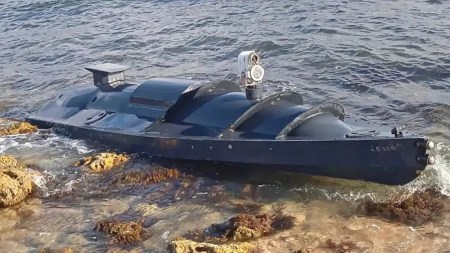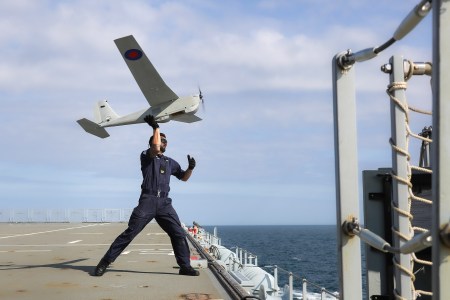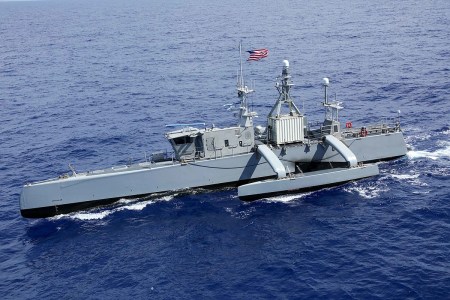
In recent months maritime drones have hit the news headlines as they are increasingly deployed in conflict hot-spots around the world’s seas. The war in Ukraine, tensions in the ocean around China, and most recently armed attacks on shipping in the Arabian Gulf and Red Sea have all been characterised by the use of various types of drones – uncrewed aircraft, drone boats, unpowered marine ‘glider’ craft, and underwater vehicles.
Our new study, ‘The Next Wave’, investigates the development and use of maritime drones and the likely future implications of their use in combat. While uncrewed boats have long been used in warfare – with the US Navy first using uncrewed underwater vehicles (UUVs) for mine clearance in the 1990’s – today, maritime drones are used by an increasing number of states and non-state groups. This study reviews the reasons why, summarizes developments by the major military powers and the UK, and examines a set of case studies to identify how drones have been used during different types of conflict at sea.
Why drones at sea?
Maritime drones are a fraction of the cost of a conventional destroyer or submarine and represent a new vision of naval warfare that exchanges small numbers of high-value military assets for large numbers of cheaper, flexible, and simpler platforms which, working together, have a greater overall capability. In this vision, platforms can be modular, able to carry a number of payloads such as weapons, sensors, or smaller drones depending on the mission, and work as a connected network using artificial intelligence computing methods to stay in touch with other members of the fleet and with human controllers. An adversary would be overwhelmed with a multitude of small targets instead of a few large warships.
Drones can gather information about the ocean more cheaply than larger crewed vessels, and may also be able to reach areas that would be inaccessible for a larger ship. They are not bounded by the physiological limitations of human personnel and can undertake assignments that humans find demanding, such as deep diving or an extended submarine mission. They are also more easily able to loiter undetected than a larger ship, allowing data to be collected over a longer time period, and can also allow potentially dangerous objects to be examined remotely, reducing risks.
Within the world’s vast oceans, certain locations are particularly strategically important for both military and civilian purposes. These include the Arabian Gulf, the Red Sea, areas around disputed islands in the South and East China Seas, the Greenland-Iceland-UK Gap, the Baltic Sea and the English Channel. These areas often represent choke points and are both crowded with marine traffic and focal points for concentrations of underwater infrastructure. Drone networks are an attractive option for military planners when undertaking surveillance and reconnaissance operations in such areas.
Military development of maritime drones
The world’s major military powers are all keen to develop drones for use in warfare, recognising the military potential of new technologies, and have all begun research and investment into next-generation weaponry and technologies such as artificial intelligence (AI) and uncrewed and autonomous systems. China, Russia and the US and its NATO allies have a highly competitive relationship in these fields, and are actively developing such capabilities, including systems for use in the maritime domain, with Russia lagging somewhat behind China and the US.
Like the larger powers, the UK is keen to exploit the potential of uncrewed and autonomous technology for military purposes. The Royal Navy sees maritime autonomous systems as a major component of its future fleet, operating on and under the sea and in the air on both front line logistics and support tasks. To date, the UK has used uncrewed technologies to undertake routine tasks such as survey work and dangerous operations such as minesweeping, and in the longer term it has the aims of automating and roboticising many of the roles of its capital ships and equipping them with uncrewed aerial, surface, and undersea vehicles to contribute to a low cost weaponised sensor network. The systems currently deployed by the UK are still mainly small scale and / or experimental system and the sums of money involved have been relatively modest.
The Black Sea
The final part of ‘The Next Wave’ examines the use of maritime drones in three different parts of the world to identify how their military applications are evolving. The report reviews the Black Sea, Arabian Gulf, and South and East China Seas as case studies of situations where maritime drones have been used to advance the security interests of the players involved. Between them, the three case studies demonstrate the use of a wide range of operating concepts for maritime drones, including intelligence, surveillance, and reconnaissance tasks; offensive operations, and the deployment of persistent autonomous networks of drones.

Following Russia’s annexation of Crimea in 2014, NATO has been conducting intelligence-gathering flights in the Black Sea region using both crewed aircraft and drones. Among the drone operations known to have taken place are flights by both NATO and US RQ-4 Global Hawk drones and US Reaper drones. The use of uncrewed maritime surface vehicles by Ukraine has also been a dramatic feature of its war against Russia. Ukraine is believed to have conducted at least 13 attacks on Russian forces using sea drones as of September 2023, targeting military ships, the naval port at Sevastopol, and Novorossiysk harbour. Since then at least two more high-profile attacks by Ukrainian drone boats been reported, sinking the Russian missile corvette Ivanovets and the landing ship Caesar Kunikov in February 2024. Ukrainian security forces have claimed that these attacks were undertaken using suicide drone boats specially developed by the Ukrainian military in the aftermath of the 2022 invasion, apparently based on simple, low-cost commercially available technology and are equipped with a camera; communications equipment relying on commercial satellite networks; sensors, and a payload of several hundred kilograms of explosives
Ukraine’s drone boats appear to have played a substantial role in constraining Russian naval operations in the Black Sea and damaging supporting infrastructure. In response Russia has employed signal jamming techniques and bolstered physical defences around key naval bases and the Kerch Bridge, with satellite images showing nets, booms, and pontoons deployed as barriers at the entrance to the Sevastopol port to prevent sea drones from entering.
The Arabian Gulf and Red Sea
In the Arabian Gulf and Red Sea navigation rights and the limits of Iran’s territorial waters in the Gulf are contested, and in 2019 the International Maritime Security Construct (IMSC) was established under the leadership of the United States to ensure freedom of navigation for merchant vessels in international waters in the region. As part of these initiatives, the US 5th Fleet, responsible for naval forces in this region, established Task Force 59 in September 2021 to integrate uncrewed robotic systems and AI within maritime activity in the fleet’s area of operations. Task Force 59 focuses on experimentation and development and has the goal of using uncrewed systems of all types – aircraft, surface craft, and underwater vehicles – that have not been deployed before to combine their capabilities with conventional crewed platforms. Task Force 59 has focused on deploying inexpensive commercial off-the-shelf systems, particularly for surveillance purposes, and in doing so has worked closely with partner navies which are also deploying uncrewed systems in the area.

The Royal Navy is a participant in US-led naval operations in the Gulf and the Navy’s uncrewed minesweeping craft have been deployed in the Gulf to detect and counter sea mines. In a high-profile incident in early 2023 Royal Marines from HMS Lancaster intercepted a smuggled cargo of arms in response to observations from a US drone operating in the area. ScanEagle drones previously operated by the Royal Navy in the Gulf have been credited with similar successes and from 2024 onwards the Navy plans to deploy its Schiebel Camcopter S-100 Peregine UAV in the Gulf to conduct surveillance and reconnaissance activities.
Iran’s operations in the Gulf region are aimed at resisting containment by the US and its allies, and have adopted ‘unconventional warfare’ techniques centred around hit-and-run tactics and the use of small, fast, attack craft, often operating together as swarms. Tactics have included attacks on commercial vessels and harassment of ships operated by foreign navies with anti-ship missiles, armed speedboats, aerial drones, and remotely operated USVs. Similar tactics have also been adopted by non-state actors operating in the region. In 2017 Houthi forces in Yemen used a fishing skiff loaded with explosives and converted into a USV to severely damage the Saudi Arabian naval frigate Al-Madinah in the Red Sea, and in January 2024 a USV packed with explosives was used in an attempt to attack a US ship off the coast of Yemen. Aerial drones have also been used to launch attacks on shipping in the region, most notably the drone attack on the oil tanker Mercer Street that took place off the coast of Oman in July 2021 and a string of further attacks which took place following Israel’s October 2023 invasion of Gaza.
The South and East China Seas
Over recent years a plethora of news reports have marked the recovery of sea drones from the waters of the South and East China seas. Chinese Haiyi drones have been found in waters around the South China Sea on a number of occasions. Chinese media have also reported on the discovery of “foreign spy devices”, most likely glider drones deployed by US, Japanese, or possibly Taiwanese forces.

Naval rivals operating in the region are using gliders and sea drones to operate surveillance networks covering wide areas of the ocean. As well as gathering oceanographic data, the drones may also play a role in mapping the sea bed, identifying underwater infrastructure, and tracking surface vessels and submarines.
Some military analysts consider that the use of uncrewed craft and drones could play a central part in future strategy should war break out between the US and China over Taiwan. Should China, a drone superpower, attempt to occupy Taiwan it could be expected to deploy swarms of drones to overwhelm defences. The military think-tank RAND has proposed that the US should deploy a surveillance network of large numbers of small, low-cost, expendable drones which could be used to observe shipping in the Taiwan Strait and identify targets for conventional weapons-delivery platforms to attack, or themselves undertake attacks operating together as swarms.
Trends and risks
‘The Next Wave identifies a number of trends and risks resulting from the use of drones at sea:
- In general, increasing the militarisation of areas of tension is destabilising and dangerous. If drones are deployed in a zone where there are tensions between nations there is a risk that surveillance, spying, or other missions may escalate tensions.
- There is a perception that drone use is politically less risky than the use of piloted systems, and also that drones have greater surveillance capabilities than crewed aircraft. This may reduce inhibitions about deploying them, risking lowering the threshold for military interventions.
- With no international agreements or codes of practice in place on the acceptable use of drones, the presence of drones in a sensitive region may over time lead to further proliferation in their use and fuel regional arms races.
- Deployment of increasingly autonomous military systems – particularly at sea, where communication is difficult, raises concerns about the level of human control over their activities and whether they remain under meaningful human control.
- Activities at sea – particularly those underwater – are more difficult to observe and monitor than activities on land or in the air, leading to questions about what levels of transparency are needed over maritime drone operations.
- Drone technology – for both aerial drones and drone boats – is relatively cheap and easily obtained. As a result drones are routinely being used by non-state actors in combat.
Remote-controlled and autonomous military systems have been increasingly used at sea and in the ocean over recent years and there is every reason to believe that their use will continue to expand over the next decade. Unfortunately, such technologies only exacerbate global tension and instability. Real security lies instead in reducing tensions between states, building equality and trust between peoples, and working to tackle the global inequalities which lead to conflict.
